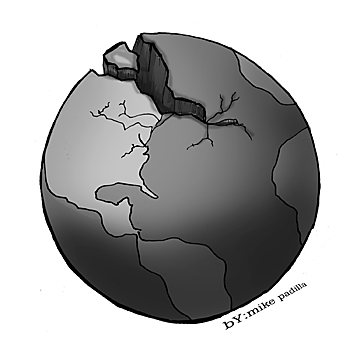
Illustration by Mike Padilla
|
|
By Dillon Fishman
Arizona Daily Wildcat
Tuesday, April 19, 2005
Print this
About an hour's drive on Interstate 90 south of Tucson, the relentless Arizona sun heats up the road so that it's almost possible to hear the tires stretching as the rubber noisily grips the pavement. Near there, like a mirage ensconced among miles of baking desert sand, cacti and lifeless tumbleweeds, suddenly appears a beautiful, emerald-framed oasis.
The San Pedro River, which flows north from the mountains of Sonora, Mexico to the Gila River in Southern Arizona, is one of the most biologically diverse areas in the world. Outlined by a row of lush, green cottonwood trees, the area, known as a "riparian corridor," is home to hundreds of species of birds, amphibians and mammals.
The corridor is striking to behold and worthwhile to visit. Guides teach about the corridor's importance as a passageway for the past 10,000 years, current environmental crises such as water shortages, and ongoing problems affecting the San Pedro such as illegal immigration and forest fires.
Walkers also learn that more than 300 species of birds, many migrating between the Americas, stop along the corridor where they join 200 species of butterflies and 20 species of bats.
The river corridor provides food, shelter and water for these migratory birds. The birds, in turn, offer more than mere aesthetic enhancement. They pollinate, disseminate seeds, eat insects and are themselves food for predators in a larger ecosystem.
However, largely through human activities such as loss of forest, wetland and desert habitats, many animals are dying. Urban development and chemical pollution are two main killers.
As human populations grow in nearby areas such as Sierra Vista, developments encroach on the corridor's boundaries and compete for its limited water. Depleting the San Pedro's water supply threatens the life that it protects and sustains. And maintaining the balance in that ecosystem is necessary to ensuring equilibrium in other ecosystems in North America and beyond.
One laudable event happened in 1988, with the establishment of the Riparian National Conservation Area along the San Pedro. That's a step in the right direction, but it's not enough.
More broadly, the San Pedro microcosm typifies environmental crises everywhere.
The 35th annual Earth Day this Friday reminds us again that much work remains to be done, throughout Arizona and the world.
Since its inception in 1970, Earth Day has been a unique day because, unlike many other holidays, it commands ostensible support from people of all political stripes. No one wants to be publicly branded with the epithet of "litterbug" or an "Earth-hater."
Earth Day is a special, warm fuzzy day. Politicians, from liberal Democrats to conservative Republicans, can join hands, sing kumbaya and publicly proclaim their undying support for causes that include fights against oil spills, heavily-polluting factories and the loss of wilderness.
But after the singing, revelry and merriment end, one has to ask: Why can't we achieve more progress on behalf of these causes, admittedly so worthy and so professedly important, during the other 364 days of the year?
Remember, things aren't looking auspicious for Mother Earth.
Drilling and destruction have been approved for the Arctic National Wildlife Refuge, despite warnings that whatever oil we glean from it will fail to wean the United States from the big teat of Middle Eastern oil. Not good.
Sport utility vehicles are still selling like hotcakes, even as gas prices reach astronomical highs. Heck, this past week students could even buy a new SUV on campus - parked conveniently on the UA Mall's grass. (This maximizes killing: Before the gas-guzzlers spit noxious fumes into the air, they can take out a few renegade blades of grass and maybe some small critters).
"Kyoto Protocol" is as familiar to most Americans' lexicon as fasting is to Rosie O'Donnell.
Yup, saving the Earth is a tough one. I might need to hit up Starbucks for some energy while I contemplate the problems associated with mass consumption and development.
Perhaps Earth Day just needs a good movie to galvanize popular support. Bill Murray's "Groundhog Day" memorialized the day in early February when a small rat-like creature pokes its head out and supposedly predicts the weather.
Nah, it'll never work.
The short answer, of course, is that saving the Earth's greenery doesn't line anyone's wallet with green. In other words, it's the money, stupid.
Unless environmentalism becomes a serious ballot issue - mobilizing us to vote and forcing legislators to act - we can expect more of the same from politicians: mere lip service.
And because environmentalism isn't likely to become a trump issue soon, take a trip down and enjoy the San Pedro while you still can.
Dillon Fishman is a third-year law student. He can be reached at letters@wildcat.arizona.edu.
